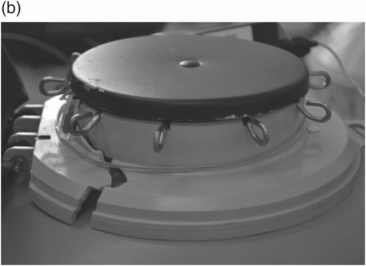
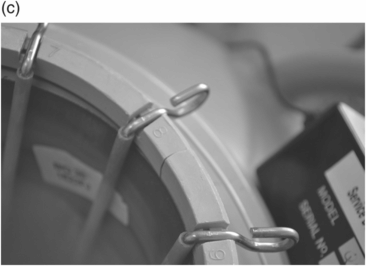
| Specification | Typical analysis (by volume) | |
|---|---|---|
| Nitrogen | > 99.999% | > 99.999% |
| Oxygen | < 5 ppm | < 2 ppm |
| Water | < 2 ppm | < 1 ppm |
| Carbon dioxide | <0.5 ppm | |
| Carbon monoxide | < 1 ppm | |
| Nitrous oxide | < 0.1 ppm | |
| Total hydrocarbons | <1 ppm | |
| Methane | < 0.5 ppm | |
| Acetylene | <0.05 ppm |
Safety precautions for handling liquid nitrogen
Cryostore specifications
1. Location: LN2 must only be handled in a well-ventilated area, ideally in a room with an external wall and exit door to the outside, or an internal room with fitted external vents. A window in the internal wall/door allows personnel in the room with LN2 to be visible at all times. Optimally, the room could be designed to be at a slightly lower level (6 inches to 1 foot) relative to adjacent rooms; N2 gas is heavier than air, and sinks when LN2 is decanted. If too much gas is accidentally produced, a lower depth to the cryostore allows access to higher external ground in an emergency, away from the asphyxiating gas. Proper use of a cryostore should ensure that a low O2 atmosphere is never created.
2. Flooring: ideally extending up the wall to a height of 3 inches. Vinyl will crack when exposed to LN2, and should not be used as a floor covering. A steel plate or thermocrete scree can be layered over the area where LN2 will be decanted.
3. Low O2 monitor with visual and audible alarm: fixed at a height of 5 feet above the floor inside the cryostore room. The alarm usually has two stages, triggered at 19.5% and then at 18.5% oxygen; it should be linked to a digital display repeater outside the room, so that it is absolutely clear whether or not it is safe to enter the room in an emergency. Do not enter if the low O2 monitor indicates that it is not safe to do so, unless specific breathing apparatus is available! Portable low O2 monitors may be used, but only as an extra safety device, and never in place of a fixed monitor. If you enter a low O2 atmosphere with only a portable monitor, the alarm will be triggered, but you may immediately collapse due to asphyxiation.
Safety
1. Write an SOP (in layman’s terms) to cover correct procedures and behavior for all staff with access to the cryostore and LN2, including clear instructions regarding emergency procedures and contacts. Basic emergency procedures can be displayed on the wall of the cryostore where they are clearly visible.
2. Training: all staff who work with LN2 or who might be involved in an emergency must have adequate training, carried out on-site in the cryostore facility by an instructor with comprehensive knowledge of health and safety during LN2 handling. A written record should document completed training, and no-one should be allowed to handle LN2 without full training.
3. On-call system for cryostore emergencies out of normal working hours: ideally, the cause of the alarm can be first assessed by the on-call staff in order to decide whether a visit to the clinic is necessary. Immediate attendance is required if there is a danger that cryopreserved material might be compromised. Only staff who are able to get to the clinic within a specified period of time in order to effect a remedy should be included in the on-call rota (See Chapter 12).
4. Risk assessment can determine the likelihood of a cryostore incident, and the potential severity of outcome. Not all risks can be accounted for (e.g. natural disasters – see Chapter 12), but all avoidable risks should be considered. Risk can be minimized by reducing the amount of LN2 stored, and by regular checks of all monitors and extraction systems. Low level O2 and N2 alarms can be tested weekly when dewars are topped up. Practice drills can ensure that everyone knows what to do in an emergency. If pressurized vessels or dewars need to be wheeled through a public area, e.g. a public corridor of a hospital, first carry out a risk assessment of the route. If elevator transport is required, use it only for the LN2 vessel, with no accompanying personnel: a leak could cause asphyxiation. Block the elevator for LN2 use only, with exits on all floors blocked off by the clinic team. One member of the team can send the vessel in the elevator to the required floor, and a receiving member of the team can remove the vessel at its destination.
5. N2, as liquid or as vapor, can cause cryogenic burns that must be treated immediately. Never handle LN2 without personal protective equipment (PPE):
A face shield (safety goggles will only protect the eyes, not the face)
Dry insulated gloves that should be loose fitting for quick removal in an emergency, but ideally with an elasticated wrist band to prevent nitrogen from splashing into them (Fig. 10.2)
Do not wear boots or clogs unless trousers are fully tucked outside them – any LN2 that splashes into a boot/clog cannot escape, and will cause burns
An overall or apron with long sleeves is also advisable.
If LN2 has splashed onto clothing, remove it immediately if possible, bearing in mind that removing “frozen” clothing directly stuck to the skin can cause more skin damage. Cotton clothing can ‘hold’ LN2 for several seconds, and this will increase the risk of burns if it is in contact with skin. If cotton socks are worn in cryogenic boots, always tuck trousers completely outside them. Be aware that extremely low temperatures can cause materials to become brittle, so that they break easily. Skin that has been in contact with a cryogenic agent should be gently immersed in cold water for a minimum of 10 minutes. Do not use warm or hot water, or dry heat. Depending on the severity of the burn, return of capillary blood supply will gradually turn the skin color red. Cover the affected areas with a sterile dressing, and request medical assistance.
Personal protective equipment used for liquid N2 handling.
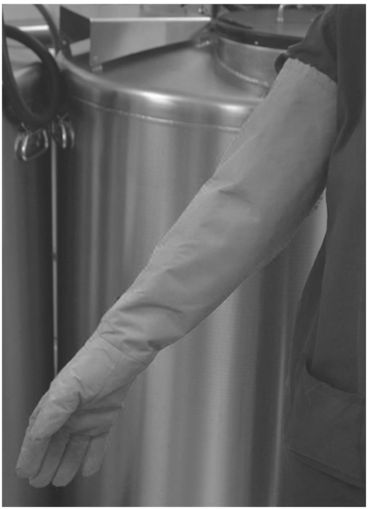
Long cryoglove.
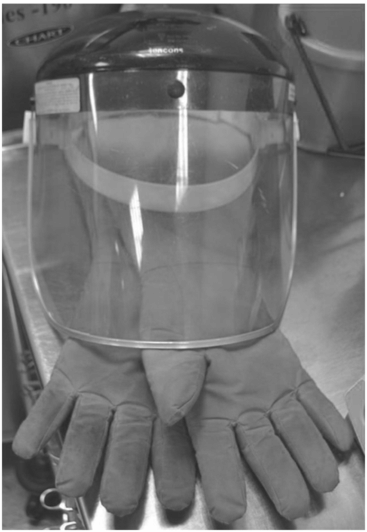
Full face guard and cryogloves.
Two young researchers were found unconscious next to three LN2 dewars in a University cold room, and died in hospital 1.5 hrs after cardiopulmonary resuscitation. Dark red discoloration on the skin of the left arm was found on one of the researchers at autopsy. Histology confirmed that the skin damage was inflicted by cold due to direct LN2 exposure before death. The cause of death was asphyxia due to O2 deficiency, and the skin histology demonstrated LN2 contact (Tabata et al., 1995).
Cryostore audit
Each canister in a dewar can hold multiple goblets, and quick access is facilitated by using a unique colour for each goblet within the canister (Fig. 10.3). This speeds up placement and removal from cryostorage, and also helps in tracking samples during an audit. Using digits for the individual canes can also be useful. For example, embryos for patient X in “dewar 2,” “canister 3,” “cane 6,” “blue goblet,” can be more easily located compared to using a system without number or colors. Needless to say, an accurate up-to-date record of the location of all cryopreserved material is essential.
Cryostore management.
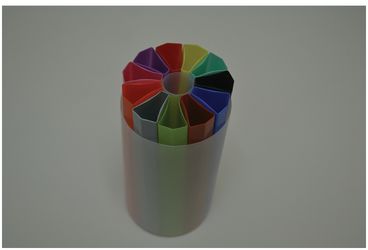
Colored goblets help in keeping track of samples. They can be arranged in alphabetical order, as shown here: aqua, black, blue, brown, green, gray, orange, pink, purple, tangerine, yellow, or in the order of the rainbow/white light spectrum.
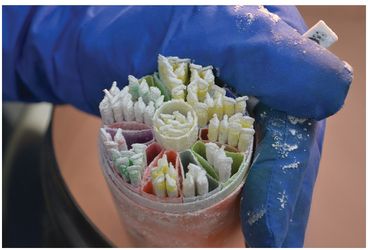
A canister that has just been removed from liquid nitrogen, containing straws that are distributed between different colored goblets.
Stay updated, free articles. Join our Telegram channel

Full access? Get Clinical Tree


